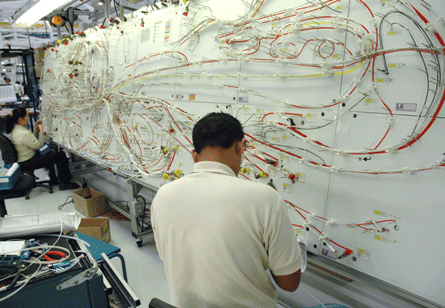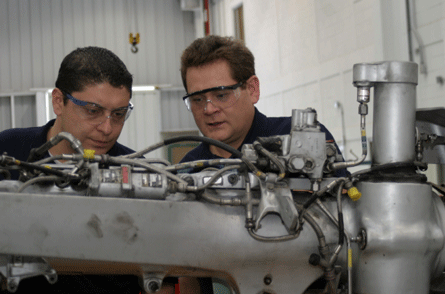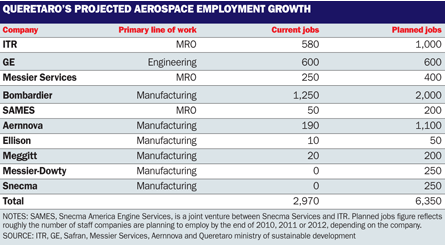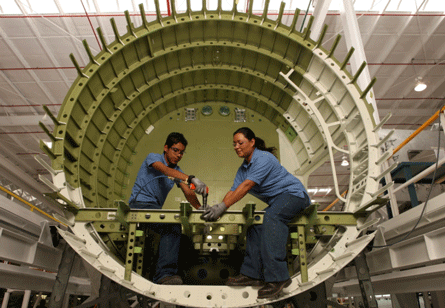Bombardier's Mexico Manufacturing Centre sits all by itself in a large, barren area near a sleepy airport 45min from the colonial city of Queretaro. But if all goes to plan, in a few years Bombardier will be the anchor of a bustling aerospace cluster capable of handling an entire aircraft programme, from airframe to engines and from development to final assembly.
That might seem a stretch of the imagination, given that Bombardier is the only tenant of an aerospace park that opened in 2007 and is still a work in progress, with its infrastructure half completed. But seeing how far Queretaro has come since Bombardier committed in late 2005 to becoming the park's first tenant, it seems the state is on track to fulfil its vision.
|
|---|
At the start of 2006, Queretaro had only two aerospace employers and fewer than 100 aerospace manufacturing jobs. Since then, six companies have opened nine facilities in the central Mexican state, including two Bombardier factories at Queretaro Aerospace Park, plus five factories and two maintenance shops at other locations. Within the next year, six more aerospace factories are due to open - four at the aerospace park and two elsewhere.
Bombardier Mexico Manufacturing Centre vice-president Real Gervais says: "We don't need an airport, but for the future, if we think we want to develop an airplane, the best thing for us is to have all the plants in the same area, to have suppliers in the park, and then we can make a complete plane. If Safran is here with engines, if we're here with aerostructure, if Aernnova is at the Queretaro Industrial Park, if ITR is downtown, then we have everything to build a complete plane in Mexico. We have the companies and capabilities to do that."
Marcelo Lopez, Queretaro's undersecretary of economic development, acknowledges the biggest challenge could be recruiting and training the more than 3,000 additional employees that will be required as all the new factories open and spool up (see chart). But Queretaro recognised this problem at an early stage and has invested in new training programmes and universities, he says. "We believe the key difference of what is now happening in Queretaro and what is happening in other states in Mexico is the possibility to have training courses for the companies. We are working very hard to give them what they need."
TRAINING PLAN
Aernnova Mexico director general Javier Perez agrees, saying: "The state government has a well-structured plan to train an aerospace workforce." Perez says the aerospace programme the government set up in 2006 at the Queretaro University of Technology (UTEQ) was a decisive factor in Aernnova selecting Queretaro over the northern Mexican state of Chihuahua. Aernnova has been using UTEQ to train its technicians, which it hires directly from high school, since November 2007. The first batch of students graduated in early 2008 and all 130 of its technicians have since gone through the three-month programme.
 |
|---|
© BombardierQueretraro recognises the need for skilled workers |
Aernnova Mexico will rely on UTEQ as it expands its workforce from 190 to 1,000 to 1,200 in the next five years. The company, which last year opened two factories producing metallic components and assemblies for Bombardier, Embraer and Sikorsky, plans to open a third factory at Queretaro Industrial Park late this year or early next year to produce composite components. Although Aernnova's training course was specifically developed for the company by UTEQ, Perez says it follows the training model first developed by UTEQ for Bombardier. "From the experience of Bombardier, we knew how these people were responding," says Perez.
Gervais says that immediately after selecting Queretaro, Bombardier started working with UTEQ to develop a three-month course in time for its first batch of Mexican technicians. UTEQ professors went to Montreal, where they learned first-hand the curriculum at a school Bombardier uses for its Canadian recruits. Canadian teachers from Montreal also spent 18 months in Queretaro making sure UTEQ was following the curriculum appropriately. About 1,000 technicians have since completed UTEQ's Bombardier programme.
 |
|---|
© BombardierQueretaro has invested in new training programmes and universities |
Gervais says the tie-up with UTEQ is "vital" and a key factor in Bombardier selecting it over three other Mexican cities it had shortlisted - Chihuahua, Monterrey and Saltillo. In Chihuahua, aerospace employers, including Hawker Beechcraft, have had to set up their own training programmes, says Gervais. "We thought if we have well-planned training organised with a university or school, we could ramp up faster and wouldn't have to worry about it. My mandate was to grow the business fast and do it well. There were things I didn't want to get involved with, training being one of them."
Bombardier's relationship with UTEQ continues to expand and UTEQ professors are in Montreal again, this time learning a curriculum that will be used to train workers at the new composites factory. This factory, which will open in November and be dedicated to producing the fuselage and wing for the new all-composite Learjet 85 business jet, is projected to have 600 employees within two years.
Bombardier, which still plans to have 2,000-2,100 employees in Queretaro by the end of 2010 despite recently cutting its Mexican workforce by 50, will also rely on UTEQ as it continues to expand its three existing factories. Bombardier now produces Challenger 850 fuselages and Q400 flight controls at El Marques Industrial Park, where it opened its first Queretaro factory in 2006. At the airport, Bombardier is producing Global Express aft fuselages and harnesses for several models at two adjacent factories.
"We chose Queretaro based on many factors, the first being the engagement of the state to develop," says Gervais. "We felt they were more engaged and had a more solid plan than the others. They were very active in promoting and going to help support the educational system. We had other criteria, but the most important ones were government engagement into this new industry, the education system in Queretaro, and the availability of starting a new school quickly to work with us."
Recognising that highly skilled workers would also be required to develop its aerospace industry fully, the Queretaro government committed early on to establishing an aerospace engineering programme. The National Aeronautic University Queretaro (UNAQ), which opened at the airport in January, is one of only three schools in Mexico offering an aeronautical engineering course. As a branch of UTEQ, UNAQ is also taking over all the aerospace technician courses that were initially provided by UTEQ in central Queretaro. Lopez says the first batch of 48 engineers will graduate in four years' time.
 |
|---|
Although Aernnova and Bombardier do not require university-trained workers at the moment, such recruits are needed at Messier Services and ITR and may eventually be required at other companies, including Bombardier and Safran. "Right now we're not manufacturing anything here," says Gervais. "Right now we're assembling parts here. But what we want to have is people that will be manufacturing parts, so we will need experts for machining - engineers in material processes and all the processes you need to build aircraft."
Safran Group's senior executive vice-president for international development, Emeric d'Arcimoles, says that although the company's two new factories that will open early next year at Queretaro Aerospace Park will not require engineers, UNAQ will be needed to pursue the development projects it aims to bring to Mexico. "The decision by the Queretaro government to invest in a university between Bombardier and us was a strong motivation for us to invest," he adds. "The next step for us is development activities."
D'Arcimoles says the new factories will produce only "simple parts at the beginning," including CFM56 engine spools and blades for Safran subsidiary Snecma, and landing gear fittings, sliders and bogie beams for sister company Messier-Dowty. But, over time, he expects these factories to expand into more complex parts, requiring a more educated workforce. D'Arcimoles says the opening of UNAQ prompted Safran to focus all its future Mexico expansion at the Queretaro Aerospace Park, including a possible research and development centre. The two factories Safran subsidiary Labinal has in Chihuahua and the Messier Services Americas (MSA) shop at the Queretaro Industrial Park will stay in their current locations, however.
MSA managing director Claude Gobenceaux says his company, which employs 50 engineers, has begun working with UNAQ. More importantly, it has worked with the Queretaro government to establish the first aerospace mechanics course outside Mexico City, he adds. The National College of Professional Technical Education (CONALEP), which offered an aerospace mechanics course at its Mexico City campus, began offering the course at its Queretaro campus in September.
So far, MSA has been able to recruit mechanics mainly from airlines in Mexico City, but it realises that, eventually, there will also be a need to recruit locally, he adds.
Lopez says that, from 2010, CONALEP will turn out about 90 mechanics a year - sufficient to meet the requirements at MSA, ITR and the new joint-venture CFM56 overhaul shop owned by ITR and Snecma Services. CONALEP's Queretaro course focuses on engines and landing gear, while the Mexico City course concentrates more on airframes.
Gobenceaux says CONALEP will help MSA expand its workforce beyond the current 250 as it continues to ramp up. MSA, which opened in early 2007, overhauled 250 mainly narrowbody landing gears last year, but this figure is expected to rise steeply and Gobenceaux expects to expand capability in the future to include larger widebody gears. "It's a big challenge today as we have to continue ramping up. We need people with a high level of skill. "
ITR chief executive Emilio Otero says his company is also working with CONALEP as well as UTEQ and UNAQ. ITR, which has been overhauling Pratt & Whitney JT8D engines in Queretaro since 1998 and has almost 600 staff, for several years hired mainly from aerospace technical schools in Mexico City. "It was more difficult to retain people here, so we decided to recruit more locally," he adds.
Otero says ITR hires from several local technical schools, with graduates going through a six-month course administered by UTEQ followed by six months' on-the-job training. Although ITR was able to thrive for years with no local aerospace educational programmes, Otero views the new schools positively as they should provide a steady supply of new students and make poaching unnecessary. "In the last few years, we've been the source of employees for others," he concedes. "It's been a little bit of a stress for us. But in the medium term, it will be good to have an aerospace cluster here because there will be more people around and more people to hire."
ITR plans to hire engineers as it begins developing a new low-pressure turbine to be used in 10,000-15,000lb thrust (44.5-66.75kN) engines powering new regional and business jets from 2014. Otero says the company will soon double the number of engineers on its payroll to about 160 for the design phase and will add 70 more before production starts.
COMPLEX WORK
The $383 million project, unveiled in February at a ceremony attended by Mexico's president, Felipe Calderon, pushes ITR and the country's aerospace industry up the food chain and into a more complex level of work. "It's a big step and it won't be easy," says Otero.
ITR's main business is now overhauling engines, although in recent years it has performed some engineering work on Honeywell engines and auxiliary power units. It also has limited manufacturing experience, producing pipes for Honeywell, Hamilton Sundstrand and Rolls-Royce. Otero says ITR plans to open a new manufacturing plant in 2011 to produce low-pressure turbines. The company also plans to open a plant next year to take over its expanding pipe manufacturing business.
The Queretaro government is keen to attract more high-tech projects, confident that ITR's development of a low-pressure turbine plant and the expansion of Bombardier and Aernnova into composites will prove to other companies that the state is ready to move up further. Lopez expects five or six more companies to commit to opening plants at the aerospace park and says there is interest from composite manufacturers. Queretaro is investing $1.5 million in a new composite laboratory, which will open at UNAQ at the end of this year. "We believe the composite lab will be another key element to attract companies," says Lopez. "There is nothing in composites in Mexico. It will be a unique training opportunity."
Although Queretaro did not have an aerospace engineer programme before UNAQ, Lopez points out that the state has always been one of Mexico's biggest suppliers of engineers generally. GE, for example, has a large engineering operation in Queretaro employing 1,200 engineers, mainly mechanical and civil. About half of these engineers work on GE Aviation projects, including design of tubes and brackets for the external parts of engines, and half for GE Energy.
In some ways, Queretaro has been an aerospace centre since the late 1990s, when both ITR and GE Infrastructure Queretaro began operations. But it was clearly Bombardier and its bold 2005 decision to open the state's first aerospace factory that put Queretaro on the global aerospace map. "Everything changed after Bombardier's announcement to come to Queretaro," says Lopez.
Bombardier has grown fast, reaching the 1,200-employee mark earlier than expected, but Gervais says its decision to start producing composite wings and fuselages just three years after opening in Queretaro shows how quickly the state's aerospace industry has grown up. "When I first came here, there was no way I would have thought we could reach the level we are at today," he says. "But we picked it up quickly. We proved we could do it."
Source: Flight International




















